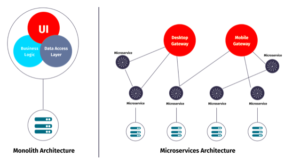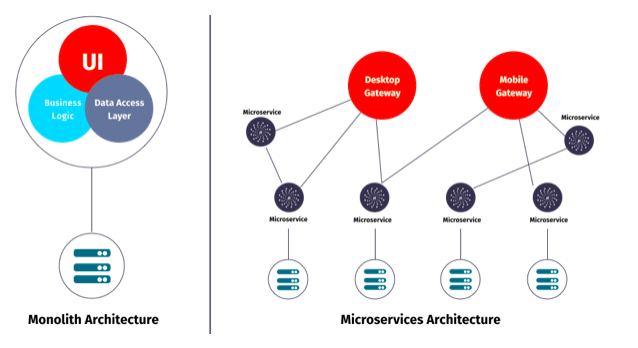Forgot to water your plants this morning? Did you know there’s an app to remind you of that? Need to see how the new fitness regime is kicking in? Install another app to track that as well. Are you out of that low-fat soy milk your roomie cannot get enough of? Get an app to add that to the grocery list! Since you are it, get that awesome app to check out a few dining-out options for that date you had been pushing off for three weekends now.

Yeah, we live in a world that’s mostly run by the applications on our phones, tablets, and computers. These apps are here to assist us all through the day. From counting calories to calculating our monthly budget, apps are here to take a load off our shoulders, so that we can freely go about our days. However, we hardly ever pause to reflect on the effort and energy (not to mention the crazy amount of caffeine for coding nights) that goes into making those apps run smoothly on our Smartphone or tablet.
Micronaut – the framework from the future!
The developers behind the applications that we use every day might just inspire a story that recounts their experiences while creating, designing, developing and testing the apps. A strange kind, developers deal with the crucial software issues that need to be fixed and dealt with, before an app is ready for the market. They are the ones to go over the processes time and again, running a code and facing frustration when it does not work the way it is supposed to.
That is precisely why Micronaut came as a boon for developers who work with Java or JVM-based systems for developing applications. Graeme Rocher is no less of a Fairy Godmother to developers who could not break the curse of too-long run times and heavy memory consumption. First unveiled at Greach 2018, Micronaut is now available for the public. You can download and install it using the easy-to-comprehend tutorials available on the official website.
This post is an overview of the features and functions of Micronaut, the revolutionary cloud-based multifunctional development framework for JVM systems. Read on to know how Micronaut has the potential to change the cloud-based framework picture for good, and the varieties it aims at bringing in its future versions.
Notable features of Micronaut
Coupled with low memory consumption, speed is undoubtedly one of the best features that Micronaut has. While most frameworks use reflection and proxies for dependency injections during run time, Micronaut offers a welcome break from the same. It takes on an innovative path and builds dependency injection data during compile time. Hence, it enables faster application start up and consumes way less memory while running.
Here are a few examples of how Micronaut functions using lesser memory and start up time to support the following systems like Grails, Spring, Groovy and Java.
- Heap sizes in Micronaut
- Java – 7 MB
- Groovy – 19MB
- Grails – 49MB
- Spring and Groovy – 33MB
- JAR files in Micronaut
- Java – consumes 8MB
- Groovy – takes up around 12 MB
- Grails – needs 27 MB
- Spring and Groovy – amount to 36MB
- Startup times
- Java – less than a second
- Spring – 3 to 4 seconds
- Grails – 3 to 4 seconds
Multi-functionality is also one of the most notable features when it comes to Micronaut. The Grails framework is said to be the inspiration behind the creation and development of this framework. That is precisely why Micronaut serves as both the client and the server. Sure, it is a web based microservice, but it does so much more than that. Its flexible format allows it to provide support for development without any of the external dependencies.
Key functions of Micronaut
We got talking with some of the leading tech experts, and learnt quite a few exciting things about the functions of Micronaut. Dr. Stephen Herald, retired professor of computer science and subject matter expert at MyAssignmenthelp opines, “Micronaut envisions the future of web development in a light that will increase productivity for developers and users alike.” Chiming in along similar lines, Micronaut creators have laid forth the essential advantages of using Micronaut to take away the most significant pain points of having to build and support entire frameworks using monolithic architecture.
Here are the most essential functions of Micronaut. Read on to know how it can save both time effort:
- Robust multi-way support for Java, Kotlin, Groovy, etc.
- Minimal reflections to ensure faster start up times and lower memory consumptions
- Building an efficient non-blocking HTTP server through Netty
- Helps spin up both servers and clients from unit tests for faster and easier testings
- Building reactive HTTP clients with a compile-time implementation that cuts down on memory consumption
- Loading compile-time dependency injection and AOP that uses aspect-oriented programming API
- Functioning as a stable cloud support for tracing tools, cloud runtimes, and common discovery services
No wonder Micronaut comes as a welcome relief for developers in scenarios where they would not be able to use traditional MVC frameworks. These mostly include applications for Android, IoT deployments, serverless functions and CLI applications.
While it keeps the MVC programming model intact, its DI/AOP container is what makes all the difference. Micronaut generates additional classes alongside your code, and creates bean definitions that help in the DI/AOP behaviour when you run the application. It cuts down drastically on start up as well as run time, and focuses on lower memory consumption, all this while being a cloud-based web development framework supporting multiple languages. It surely does not get better than this, right?
Micronaut and its upcoming versions
Graeme Rocher is of the opinion that Micronaut can provide the basis for all developmental frameworks in the future, and has the potential to reduce or eliminate all metadata and run time issues for JVM-based languages and developing systems. It already comes with superfast annotation processors that let you run an ahead-of-time (AOT) compilation that helps with the swift start-up time and low memory consumption.
For its future versions, Rocher aims at including other languages by creating a common AST. While Java, Groovy and Kotlin are already included in the Micronaut starter version, there are plans to add a Scala compiler plugin in the future. Another big name on the cards for inclusion into the Micronaut circle is Clojure. Rocher believes it would be a great addition to the framework that will also provide insightful inputs from the Clojure community.
What Micronaut endeavours to achieve?
With technology moving at a rapid pace over the last two decades, keeping up with it has been the primary challenge that budding techies had to face time and again. While systems like Kubernetes and Docker have revolutionised low memory applications with low overhead, more and more developers are opting for languages other than Java to design their apps. It is 2018, and Java still reigns supreme when it comes to developing high-end and multi-functional apps. Hence, the need to have a framework that supports Java and Java-based systems with low memory and shorter run times was the need of the hour.
Sure, you could always design a whole new app for online assignment help services using Java. However, the sheer number of technology choices in the modern times would alone result in having to run the application using supercomputers. Micronaut enables you to steer clear of that path. A fully-stacked framework for supporting Java and JVM to run your application, Micronaut aims at getting even with other lightweight frameworks that provide stable support for designing modular applications as per the needs of the industry.
Want to make the most of Micronaut?
Released for the public at Gr8Conf EU, you can install Micronaut using SDKMAN! to download and configure your favoured version of the framework. Follow these guidelines to get a first-hand tutorial on downloading and installing Micronaut on Linux, Cygwin or Mac OSX. Building robust and resilient apps using microservices is definitely made easy with the advent of Micronaut, the revolutionary in the realm of tech advancements.
Wrapping it up
JVM is undoubtedly one of the most amazing technological advancements that aids in the creation of multifunctional apps with ease. However, its optimisations are often lost on short-lived operations like Serverless functions. Micronaut aims at bridging that gap to provide a full-stack framework that supports JVM-based systems with ease. Micronaut offers full support for distributed tracing, distributed configurations, monitoring metrics and a lot more. Although it draws heavily from Spring and Grails, Micronaut itself as a framework is stable enough to make it to the top on its own. With its simplistic interface and prompt command functions, the future of application development using JVM-based models will soon be taken over by the seamless microservices offered by Micronaut. Here’s hoping for an enhanced developing, testing and designing framework with Micronaut.
Author bio:
Gracie Anderson is a hardcore techie by heart. She offers unmatched assignment help for students through MyAssignmenthelp. As a senior subject matter Assignment expert, She has shared her expertise with countless students from all over the world. She is also a part-time blogger, and enjoys writing about the latest trends in technology.











